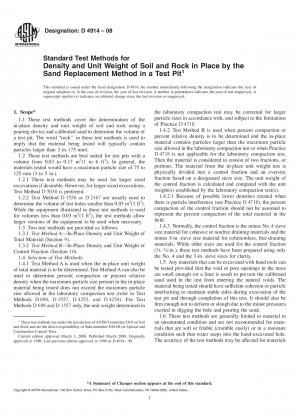ASTM D4914-08
Standard Test Methods for Density and Unit Weight of Soil and Rock in Place by the Sand Replacement Method in a Test Pit
- Standard No.
- ASTM D4914-08
- Release Date
- 2008
- Published By
- American Society for Testing and Materials (ASTM)
- Status
- Replace By
- ASTM D4914/D4914M-16
- Latest
- ASTM D4914/D4914M-16
- Scope
These test methods are used to determine the in-place density of compacted materials in construction of earth embankments, road fills, and structure backfill. For construction control, these test methods are often used as the bases for acceptance of material compacted to a specified density or to a percentage of a maximum unit weight determined by a standard laboratory test method (such as determined from Test Method D 698 or D 1557
), subject to the limitations discussed in 1.4. These test methods can be used to determine the in-place density of natural soil deposits, aggregates, soil mixtures, or other similar material.
Note 18212;Notwithstanding the statements on precision and bias contained in this test method, the precision of this test method is dependent on the competence of the personnel performing it and the suitability of the equipment and facilities used. Agencies that meet the criteria of Practice D 3740
are generally considered capable of competent and objective testing. Users of these test methods are cautioned that compliance with Practice D 3740 does not in itself ensure reliable results. Reliable testing depends on many factors; Practice D 3740 provides a means of evaluating some of those factors. 1.1 These test methods cover the determination of the in-place density and unit weight of soil and rock using a pouring device and calibrated sand to determine the volume of a test pit. The word “rock'''' in these test methods is used to imply that the material being tested will typically contain particles larger than 3 in. (75 mm).
1.2 These test methods are best suited for test pits with a volume from 0.03 to 0.17 m3 (1 to 6 ft3). In general, the materials tested would have a maximum particle size of 75 to 125 mm (3 to 5 in.).
1.2.1 These test methods may be used for larger sized excavations if desirable. However, for larger sized excavations, Test Method D 5030
is preferred. 1.2.2 Test Method D 1556 or D 2167
are usually used to determine the volume of test holes smaller than 0.03 m3 (1 ft3). While the equipment illustrated in these test methods is used for volumes less than 0.03 m3 (1 ft3), the test methods allow larger versions of the equipment to be used when necessary. 1.3 Two test methods are provided as follows:
1.3.1 Test Method A8212;In-Place Density and Unit Weight of Total Material (Section 9).
1.3.2 Test Method B8212;In-Place Density and Unit Weight of Control Fraction (Section 10).
1.4 Selection of Test Methods:
1.4.1 Test Method A is used when the in-place unit weight of total material is to be determined. Test Method A can also be used to determine percent compaction or percent relative density when the maximum particle size present in the in-place material being tested does not exceed the maximum particle size allowed in the laboratory compaction test (refer to Test Methods D 698, D 1557, D 4253, and D 4254
). For Test Methods D 698 and D 1557 only, the unit weight determined in the laboratory compaction test may be corrected for larger particle sizes in accordance with, and subject to the limitations of Practice D 4718 . 1.4.2 Te......
ASTM D4914-08 Referenced Document
- ASTM C127 Standard Test Method for Density, Relative Density (Specific Gravity), and Absorption of Coarse Aggregate
- ASTM C566 Standard Test Method for Total Evaporable Moisture Content of Aggregate by Drying
- ASTM D1556 Standard Test Method for Density and Unit Weight of Soil in Place by the Sand-Cone Method
- ASTM D1557 Standard Test Methods for Laboratory Compaction Characteristics of Soil Using Modified Effort (56,000 ft-lbf/ft3 (2,700 kN-m/m3))
- ASTM D2167 Standard Test Method for Density and Unit Weight of Soil in Place by the Rubber Balloon Method
- ASTM D2216 Standard Test Method for Laboratory Determination of Water (Moisture) Content of Soil and Rock by Mass
- ASTM D3740 Standard Practice for Minimum Requirements for Agencies Engaged in the Testing and/or Inspection of Soil and Rock as Used in Engineering Design and Construction
- ASTM D4253 Standard test method for maximum index density and unit weight of soil using a shaking table*, 2024-04-19 Update
- ASTM D4254 Standard Test Methods for Minimum Index Density and Unit Weight of Soils and Calculation of Relative Density*, 2024-04-19 Update
- ASTM D4718 Standard Practice for Correction of Unit Weight and Water Content for Soils Containing Oversize Particles
- ASTM D4753 Standard Specification for Evaluating, Selecting, and Specifying Balances and Scales for Use in Soil, Rock, and Construction Materials Testing
- ASTM D5030 Standard Test Method for Density of Soil and Rock in Place by the Water Replacement Method in a Test Pit (Withdrawn 2003)
- ASTM D6026 Standard Practice for Using Significant Digits in Geotechnical Data
- ASTM D653 Standard Terminology Relating to Soil, Rock, and Contained Fluids
- ASTM D698 Standard Test Methods for Laboratory Compaction Characteristics of Soil Using Standard Effort (12 400 ft-lbf/ft3 (600 kN-m/m3))*, 2024-04-19 Update
- ASTM E11 Standard Specification for Wire Cloth and Sieves for Testing Purposes
ASTM D4914-08 history
- 2016 ASTM D4914/D4914M-16 Standard Test Methods for Density of Soil and Rock in Place by the Sand Replacement Method in a Test Pit
- 2008 ASTM D4914-08 Standard Test Methods for Density and Unit Weight of Soil and Rock in Place by the Sand Replacement Method in a Test Pit
- 1999 ASTM D4914-99 Standard Test Methods for Density of Soil and Rock in Place by the Sand Replacement Method in a Test Pit
